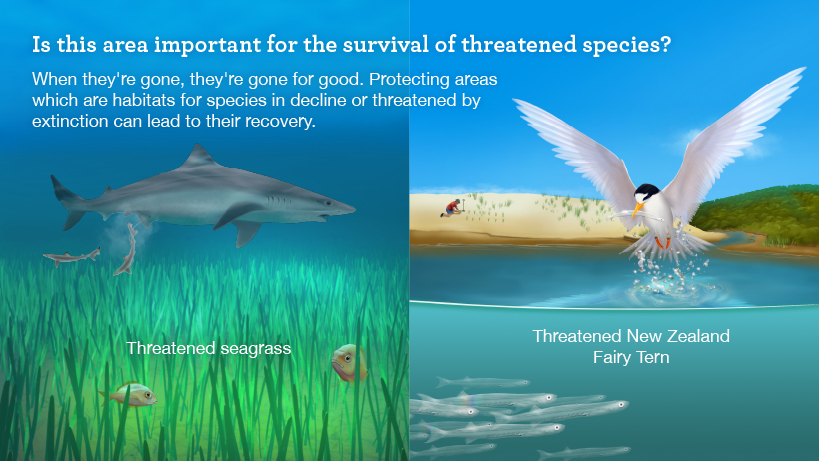New marine protections in the Hauraki Gulf/Tīkapa Moana
Introduction
The Government plans to introduce 19 new protection areas in the Hauraki Gulf/Tīkapa Moana.New marine protections proposed for the Hauraki Gulf/Tīkapa Moana
You can find further details on the Hauraki Gulf/Tīkapa Moana Marine Protection Bill on the New Zealand Parliament website.
This network of marine protection builds on the aspirations of the Sea Change Tai Timu Tai Pari plan. It incorporates feedback from tangata whenua, stakeholders and the public. It will use both new and existing marine protection tools.
The protection consists of:
- 2 marine reserves; extending from the existing reserves Te Whanganui-o-Hei/Cathedral Cove Marine Reserve and Cape Rodney – Okakari Point (Goat Island).
- 12 high protection areas (HPAs) – these areas protect and restore marine habitats and ecosystems. They also provide for the customary practices of tangata whenua
- 5 seafloor protection areas (SPAs) – these areas protect seafloor habitats. But they still allow for activities that do not damage them, such as non-bottom contacting fishing.
The marine protection aims to support tangata whenua in their roles as kaitiaki and rangatira, and acknowledge the cultural value of Tīkapa Moana.
The areas were chosen because they meet criteria such as:
- being at-risk
- being rare
- having a large range of diverse wildlife
- representing an important habitat or ecosystem type.
The areas would nearly triple protection in the Gulf from just over 6%, including the cable protection zones, to about 18%. This would support the recovery of some of its most biodiverse regions, including its nearshore areas and deep reefs.
When the new protection would start
The protection requires new legislation and involves the use of two new tools: high protection areas and seafloor protection areas.
Parliament is progressing this legislation in the form of a Bill, named the Hauraki Gulf/Tīkapa Moana Marine Protection Bill.
If passed into law, we anticipate the legislation and protection to be in place by late 2024.
Protection areas
The new protection areas are within the Hauraki Gulf Marine Park. The Park is not a protected area. It was established in 2000, under the Hauraki Gulf Marine Park Act, to achieve integrated management of the area across land and sea. The Hauraki Gulf Forum is the statutory body established under this Act.

A map of the 19 new marine protection areas | See larger (jpg, 6,849K)
Why we need to protect marine habitats
Consecutive State of our Gulf reports have illustrated that the Gulf is in an ongoing state of environmental decline.
Pollution, sedimentation and climate change have negatively impacted coastal and marine plants and animals.
There has also been an increasing amount of kina barrens, habitat loss and localised fisheries depletion.
The new network of protection is designed to protect and restore rare and important habitats. These host a range of different plants and animal life.
Many marine habitats act as a nursery to juvenile fish. Protecting them will help to support fish stocks over time. Some of these habitats are only found in a few remaining areas, like seagrass.
Others, like the complex reef systems around The Noises islands, provide a vital range of habitats to support important species. Like mussel beds and shallow sponge gardens.
Extensions to marine reserves
Marine reserves are areas that are protected from the sea surface to the seafloor. The entire area is strictly 'no take', including marine life, shells, rocks and driftwood.
A range of activities that do not harm marine life are permitted in marine reserves. They include swimming, snorkelling, boating and diving.
Marine reserves would extend from two existing marine reserves:
- Cape Rodney-Okakari Point Marine Reserve (Goat Island). The protected area would nearly quadruple in size. This would protect species such as blue maomao and snapper. Learn more about Cape Rodney-Okakari Point Marine Reserve (Goat Island).
- Te Whanganui-o-Hei/Cathedral Cove Marine Reserve. The protected area would more than double, protecting its hard rock reefs and plants, crustaceans, molluscs and fish. Learn more about Te Whanganui-o-Hei/Cathedral Cove Marine Reservee.
High protection area
A high protection area (HPA) aims to protect and restore marine habitats while providing for the customary practices of tangata whenua. The contributions of tangata whenua representatives have been vital in developing this protection tool.
An HPA would protect a selected zone from the surface of the sea to the bottom. This includes the foreshore.
The prohibitions include:
- commercial and recreational fishing – including collecting lobsters and other shellfish,
- large-scale removal of non-living materials like sand, stone or driftwood, and
- dumping or discharge of waste, sewerage, or litter.
Customary fishing and seafood harvesting
Authorised customary fishing could continue to occur in high protection areas. This would support Māori cultural knowledge and learning, as well as a cultural guardianship role in the marine area.
Customary fishers in high protection areas could only fish within specific regulations, that are designed to support the conservation goals for the area. Customary fishers would also need written authorisation by a Tangata Kaitiaki through the Fisheries Act 1996.
Tangata kaitiaki/tiaki are responsible for managing customary fishing in their rohe moana or area, and are the only people who can authorise customary fishing.
For more information on customary fishing rights, visit Ministry for Primary Industries – Māori customary fishing information and resources.
Setting goals for high protections area
High protection areas would allow for customary fishing that is regulated under the Fisheries Act 1996, and allow for Protected Customary Rights under the Marine and Coastal Area (Takutai Moana) Act 2011.
To make sure that customary take does not impact the conservation benefits we're aiming for, conservation goals would be set for each of these high protection areas.
These goals would help to develop regulations to manage all activities, including customary fishing, so that they are aligned with conservation goals.
We would work to set goals for high protection areas in 2024.
Seafloor protection area
A seafloor protection area (SPA) aims to maintain, restore, and protect important seafloor habitats. They also aim to protect sensitive species such as sponges and protected corals.
These areas would limit activities that have a harmful impact on the seafloor, such as:
- fishing methods that have a high impact on the sea floor like bottom trawling, dredging, Danish seining
- dumping
- aquaculture (farming fish or other wildlife in the sea – enclosed or otherwise)
- removing sand, and
- mining.
All other fishing methods (outside of trawling that touches the seafloor, dredging, and Danish seining) could continue in SPAs, such as diving for seafood, spear fishing and line fishing.
There may be additional restrictions in some of these areas. These are to protect the sensitive species.
A seafloor protection area would protect habitats created by plants and animals (biogenic). Such as dog cockles, green lipped mussels, and seagrass beds. Learn more about marine habitats.
How long it will take to revitalise the Hauraki Gulf
Wildlife systems in Hauraki Gulf/Tīkapa Moana are large and complex. Some habitat types may respond to increased protection within 1 to 2 years. Others could take longer.
There are also pressures on the Gulf that will continue despite the new protection areas. Such as pollution and climate change.
DOC would monitor the new protection areas and use of these tools to see if they are working. This would allow us to adjust to changes or other pressures when needed.
The protection areas are only one part the Revitalising the Gulf plan. Others are being rolled out, including fisheries measures, work to restore natural habitats and address land-based impacts.
All of these actions are required to reverse the decline in the Hauraki Gulf/Tīkapa Moana. It will take several years to put in place and to take effect.
Further information
- Regulatory Impact Statement (PDF, 5,912K)
- Technical analysis of the plan’s marine protection proposals (PDF, 7,521K)
- Technical analysis of the plan’s protected species proposals (PDF, 1,172K)
- Indicative geospatial files for the plan's marine protection proposals (ZIP, 755K)
- Evaluation of biodiversity protected by Sea Change Tai Timu Tai Pari – Marine Protected Area proposals (DOCX, 12,418K)
- See other Revitalising the Gulf work programmes



